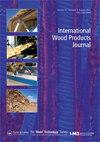Coppiced sweet chestnut in UK construction – challenges and opportunities for design development of hardwood building products
IF 0.9
Q2 MATERIALS SCIENCE, PAPER & WOOD
引用次数: 0
Abstract
ABSTRACT This study comprised two focus groups exploring technical challenges and opportunities for small diameter sweet chestnut hardwood in construction. Five structural building products were designed and fabricated informed by the findings from the focus groups. Simple mobile sawmill and manual cleaving processes were used to align with regional skills and wood processing infrastructure. The building products developed were designed to provide a regenerative alternative to imported softwood timber that dominates the UK construction sector. Radially-sawn beams were found to provide high yield from small diameter roundwood and cleaving of short lengths of coppice was an effective way of producing building products from the highest proportion of short-rotation, coppiced sweet chestnut trees.英国建筑中的甜栗子——硬木建筑产品设计发展的挑战与机遇
摘要本研究由两个重点小组组成,探讨小直径甜栗硬木在建筑中的技术挑战和机遇。根据焦点小组的调查结果,设计和制造了五种结构建筑产品。采用了简单的移动锯木厂和手动切割工艺,以符合区域技能和木材加工基础设施。开发的建筑产品旨在为主导英国建筑业的进口软木提供再生替代品。人们发现,径向锯木可以从小直径的圆木中获得高产量,而切割短矮林是从最高比例的短旋伐矮林甜栗树中生产建筑产品的有效方法。
本文章由计算机程序翻译,如有差异,请以英文原文为准。
求助全文
约1分钟内获得全文
求助全文
来源期刊

International Wood Products Journal
MATERIALS SCIENCE, PAPER & WOOD-
CiteScore
2.40
自引率
0.00%
发文量
27
 求助内容:
求助内容: 应助结果提醒方式:
应助结果提醒方式:


